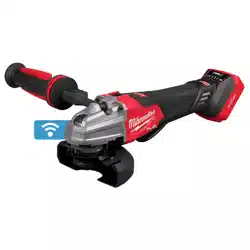Loading ...
Loading ...
Loading ...

9
Using Wire Brushes
Wire brushes are useful for removing rust, scale,
burrs, weld slag, etc.
WARNING
Everyone in the area must wear
protective clothing and safety
goggles or face shields. Fatigued wires and
residue will y o the brush with considerable
force, causing potential for serious injury.
Never exceed Maximum Safe Operating Speed of
brush. Do not use a damaged brush or one that
is functioning improperly (throwing wires, out-
of-balance, etc.). These conditions increase the
possibility of further brush failure and possible
injury. Discard and replace damaged brushes
immediately.
Do not remove the Type 27 Guard when using a
wire cup brush. Do not use with the Type 1 clip-
on guard installed. Rotate the guard as shown
below. Do not let the guard interfere with the
wire cup brush. If the wire cup brush is worn
and touching the guard, replace the accessory
immediately.
If the use of a guard is recommended for wire
brushing, do not allow any interference of the
wire wheel or brush with the guard. Wire wheel
or brush may expand in diameter due to work
load and centrifugal forces.
Always install wire brushes according to the acces-
sory manufacturer's instructions. Only use acces-
sories with threads matching the tool spindle. While
using a wire cup brush, adjust the guard for viewing
the workpiece.
Wire Wheel Brush
Type 27 Guard
Wire Cup Brush
Test wheel for balance and loose or damaged wires
by letting it spin for one minute before applying it to
the workpiece. During this time, no one should stand
in front of or in line with it.
Control pressure and surface contact between
wheel and workpiece. Too much pressure causes
over-bending of wires and heat build-up causing
premature wire breaking, rapid dulling and reduced
brush life. Instead of more pressure, try a wire wheel
with more aggressive cutting action (increased wire
size, decreased wire length or dierent brush type
(knot type vs. crimped wire type).
Using Sanding Discs
Hold tool at 5° to 15° angle to ensure proper sanding
pressure and control. Too great an angle will result
in too much pressure and could cause excessive
wear to the disc and workpiece. Too small an angle
will reduce control.
Use long, sweeping, side to side strokes, advancing
forward to produce the desired nish.
For best result use only this portion of disc
Hold at a
5° to 15° angle
Cross Sanding - When nishing a surface that
has been prepared by a coarse disc or wheel, sand
at right angles to the strokes made by the coarser
disc. Finishing marks left from previous sanding are
easily seen and removed for a uniform nish. Failure
to cross sand when changing from a coarse disc to
a nishing disc may result in deep scratches and
circular marks.
Removing Welds or Hammer Marks - When remov-
ing welds or hammer marks, limit coarse sanding to
the immediate area. Use successively ner grits to
smooth surface.
Finishing Metal - Constantly move across the sur-
face. Work faster on curved surfaces where contact
areas are smaller and pressure is greater. Flat areas
may appear at the end of the stroke when pressure
is too heavy. Ease up on pressure at end of each
stroke and when reversing strokes.
WARNING
To reduce risk of injury, always
remove the battery pack and keep
tool in storage position while transporting and
storing. Carry tool with ngers o the trigger.
Transporting and Storage Position
Troubleshooting
Deep scratches and circular marks can result from:
• Using too coarse a grit
• Using a partially glazed disc
• Dirt or loose metal on the workpiece
• Failure to sand across the grain when changing from
coarse to nishing discs
• Failure to use closed coated discs to reduce the
problem of grains working loose and scratching the
workpiece
Loading ...
Loading ...
Loading ...
